By Raj Mankad, Editor of Cite, a publication of the Rice Design Alliance
“I thought that Houston was a large sprawling mass that lacked a soul, and I couldn’t have been more wrong,” wrote one participant after The Funders’ Network (TFN) 2018 Annual Conference in Houston. His change of mind did not come about from a typical Chamber of Commerce tour through the city’s most polished areas. Rather, his change of heart came from a conference focused on Houston’s best efforts to address environmental injustices, displacement of low-income communities, climate change, and other pressing challenges.
Last year I was invited to participate in a planning session for the upcoming TFN conference in Houston, which took place just seven months after Hurricane Harvey made landfall. I found myself in a room full of many of the Houstonians I admire and funders from around the country. I wished that everyone in Houston could have shared my seat at this meeting. The power of funders is not simply in their capacity to fund projects but their ability to convene people from across sectors and frame important questions. I was honored to have a role in planning the mobile workshops with the Funders’ Network staff and dozens of local leaders. As the editor of Cite: The Architecture and Design Review of Houston, I saw the tours as an opportunity to share hard-earned optimistic perspectives from the city with a broad public in the city itself. We recently highlighted the four mobile workshops created for last year’s TFN conference on our blog. (Click on the links below for full descriptions and other resources.)
Houston Tours
Third Walking Tour: Emancipatory Art and Equitable Development
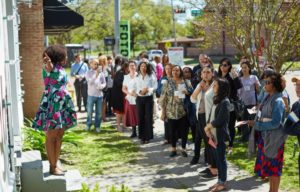 In this historic black neighborhood, artists are not just at the decision-making table – they built and set the table. Project Row Houses has long received international attention for its adaptive reuse of a block of row houses for art installations and for housing young mothers. In recent years, the organization has convened churches, residents, foundations, businesses, architects, real estate experts, and others to create a comprehensive approach to affordable housing, parks, safety, arts, schools, and more as rising land prices and speculative development threaten to displace the longstanding community. This tour gives a window into that work while taking you through the art installations, a food co-op, a bakery, and the rebuilt Emancipation Park.
In this historic black neighborhood, artists are not just at the decision-making table – they built and set the table. Project Row Houses has long received international attention for its adaptive reuse of a block of row houses for art installations and for housing young mothers. In recent years, the organization has convened churches, residents, foundations, businesses, architects, real estate experts, and others to create a comprehensive approach to affordable housing, parks, safety, arts, schools, and more as rising land prices and speculative development threaten to displace the longstanding community. This tour gives a window into that work while taking you through the art installations, a food co-op, a bakery, and the rebuilt Emancipation Park.
Ship Channel Tour: Fenceline Communities
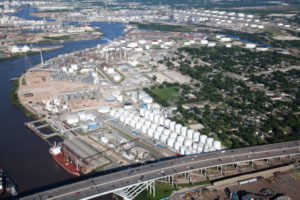 Guided visits through Manchester and other communities along the Houston Ship Channel are typically framed as “toxic tours.” While this tour takes you deep into the industrial landscape of Houston and shows the disturbing juxtapositions of refineries and houses, it emphasizes the perspectives of the people who live there and love their communities, including Juan Flores, a former city council member of Galena Park. You experience the mature live oaks, the small-town feel, the historic landmarks, and the potential for a different relationship among people, industry, and the environment.
Guided visits through Manchester and other communities along the Houston Ship Channel are typically framed as “toxic tours.” While this tour takes you deep into the industrial landscape of Houston and shows the disturbing juxtapositions of refineries and houses, it emphasizes the perspectives of the people who live there and love their communities, including Juan Flores, a former city council member of Galena Park. You experience the mature live oaks, the small-town feel, the historic landmarks, and the potential for a different relationship among people, industry, and the environment.
Bayou Greenways Bike Tour: Lessons in Urban Design on Brays Bayou
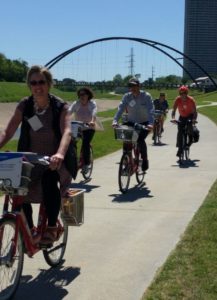 In 1912, landscape architect Arthur Comey proposed that Houston should preserve its bayous and floodways as linear parks with trails. One hundred years later, Houston voters overwhelmingly passed a $100 million bond matched by private funding to realize and expand on this vision by building hike-and-bike trails along all major bayous, connecting jobs, schools, parks, and people of all means and backgrounds. The framework for a more resilient city designed with nature was put in place before Hurricane Harvey hit. The tour takes you through parks to the port.
In 1912, landscape architect Arthur Comey proposed that Houston should preserve its bayous and floodways as linear parks with trails. One hundred years later, Houston voters overwhelmingly passed a $100 million bond matched by private funding to realize and expand on this vision by building hike-and-bike trails along all major bayous, connecting jobs, schools, parks, and people of all means and backgrounds. The framework for a more resilient city designed with nature was put in place before Hurricane Harvey hit. The tour takes you through parks to the port.
Gulfton Walking Tour: First Stop for Houston’s Immigrants and Refugees
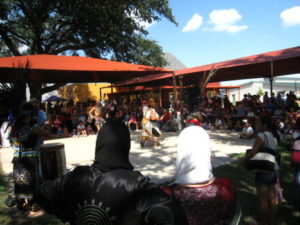 An unprecedented level of coordination, from legal services to healthcare to refugee resettlement to education, is taking place in Gulfton, an area initially built in the 1970s for young professionals and now home to families from around the world. The area has the life and density associated with early twentieth-century Brooklyn but in a “suburban” built environment.
An unprecedented level of coordination, from legal services to healthcare to refugee resettlement to education, is taking place in Gulfton, an area initially built in the 1970s for young professionals and now home to families from around the world. The area has the life and density associated with early twentieth-century Brooklyn but in a “suburban” built environment.
In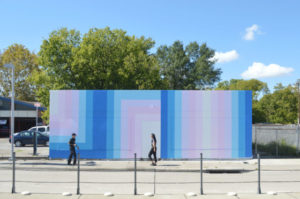 a city without traditional zoning, community-based planning has proven transformative. When Houston METRO announced plans to extend a light rail line through the Near Northside, residents both welcomed and feared the change it might bring. The area has long been an affordable and welcoming place from immigrants. The GO Neighborhoods program began with a listening campaign and established a Quality of Life agreement that has provided an organizing vision for a remarkable number of public and private efforts that have managed the change that has come in line with the ambitious dreams of residents.
a city without traditional zoning, community-based planning has proven transformative. When Houston METRO announced plans to extend a light rail line through the Near Northside, residents both welcomed and feared the change it might bring. The area has long been an affordable and welcoming place from immigrants. The GO Neighborhoods program began with a listening campaign and established a Quality of Life agreement that has provided an organizing vision for a remarkable number of public and private efforts that have managed the change that has come in line with the ambitious dreams of residents.

About the Author
Raj Mankad has served as Editor of Cite, a publication of the Rice Design Alliance at Rice University, since 2008.
